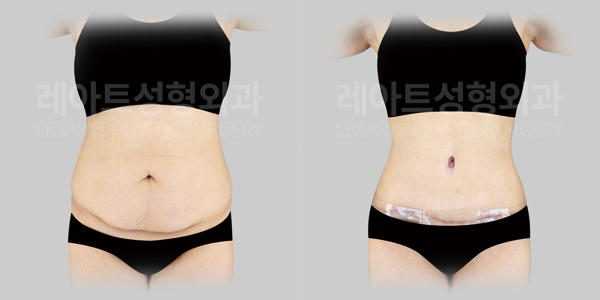If You’re Worried About Scar Management After Abdominoplasty

Information
- Age : early 30’s
- Height : 157cm
- Weight : 68kg
- BMI : 28
Surgical site
- surgical site :abdominoplasty, M-type, Triple lock, Navel Correction, abdomen liposuction, pubic area
- liposuction aspirate volume : 3500cc
One of the most common concerns for those considering abdominoplasty is the issue of scarring.
Deciding to undergo abdominoplasty requires careful consideration, and given that the procedure involves a long incision, it is natural to worry about whether the scar will remain prominent.
In the early stages after surgery, abdominoplasty scars may appear red or dark. However, over a recovery period of approximately 18 months to 2 years, they gradually fade and eventually settle into a thin, faint line.
To achieve this stable transformation, consistent and thorough scar management is essential.
Before deciding on abdominoplasty, it is crucial to have a clear understanding of the scar formation and recovery process. After surgery, following the doctor’s recommendations and post-operative care instructions is key to optimal healing.
Let’s take a closer look at the case of a patient who underwent abdominoplasty.

This patient is a woman in her 20s with no history of childbirth.
She experienced childhood obesity, with her weight exceeding 100 kg at one point. However, after reaching adulthood, she successfully reduced her weight through dieting and has been maintaining it in the upper 60 kg range.
Although she managed to lose weight, she felt limited in improving the sagging abdominal skin and the resulting body shape concerns. This led her to seek treatment at our clinic.

A preoperative body analysis was conducted to proceed with the abdominoplasty.
Despite experiencing significant body changes due to extreme weight loss from obesity, the patient maintained good skin elasticity.
Since there was minimal abdominal wall laxity, a full upper abdominal muscle repair was unnecessary. Instead, a lower abdominal correction would be sufficient.
However, skin sagging was observed from the upper abdomen, making a medium-type abdominoplasty necessary.
In addition, we recommended combining the procedure with flank liposuction and mons pubis liposuction to create a firm and smooth abdominal contour.
Since the medium-type abdominoplasty involves skin dissection up to the upper abdomen and pulling down the excess skin for removal, repositioning the navel was necessary.
We planned to reshape the belly button into a vertical form to enhance the appearance of a slimmer waistline.
Now, let’s compare the preoperative and 5-month postoperative photos.

When comparing the front-view preoperative and 5-month postoperative photos of the abdominoplasty, the transformation is evident.
The excess skin that previously sagged downward has been lifted and tightened as much as possible.
Additionally, the correction of the stretched rectus muscles has contributed to a firmer and more sculpted abdominal appearance.

Additionally, the overall reduction of accumulated fat through liposuction has resulted in a noticeably slimmer waistline.
The previously sagging navel, which had shifted downward due to abdominal skin laxity, was also corrected through the combined navel reconstruction procedure.
This not only enhances the appearance of a more defined waistline but also creates a visual effect that makes the legs appear longer.

Before surgery, when bending forward, the sagging skin appeared more pronounced due to gravity.
However, after undergoing an abdominal lift, muscle tightening, abdominal liposuction, and pubic liposuction, the abdominal contour has been significantly firmed.
The once-drooping skin is now lifted, revealing a well-defined and tightened abdominal and waistline.

This patient, like most others in the early stages of abdominoplasty recovery, had concerns about scar pigmentation, scar management, and the overall healing period.
For the initial darkened incision area, we advised patience and proper care, including timely application of scar ointments, laser treatments, silicone band placement, and adequate hydration.
The patient understood these recommendations well and diligently followed self-care routines, leading to stable recovery progress at each follow-up.
As mentioned earlier, while the lifting effect of abdominoplasty becomes noticeable quickly, scars take up to two years to fade into a fine line, making consistent post-op care essential.
Most importantly, if any discomfort arises at the surgical site after abdominoplasty, we strongly recommend contacting the hospital immediately for appropriate treatment based on symptoms and recovery stages.